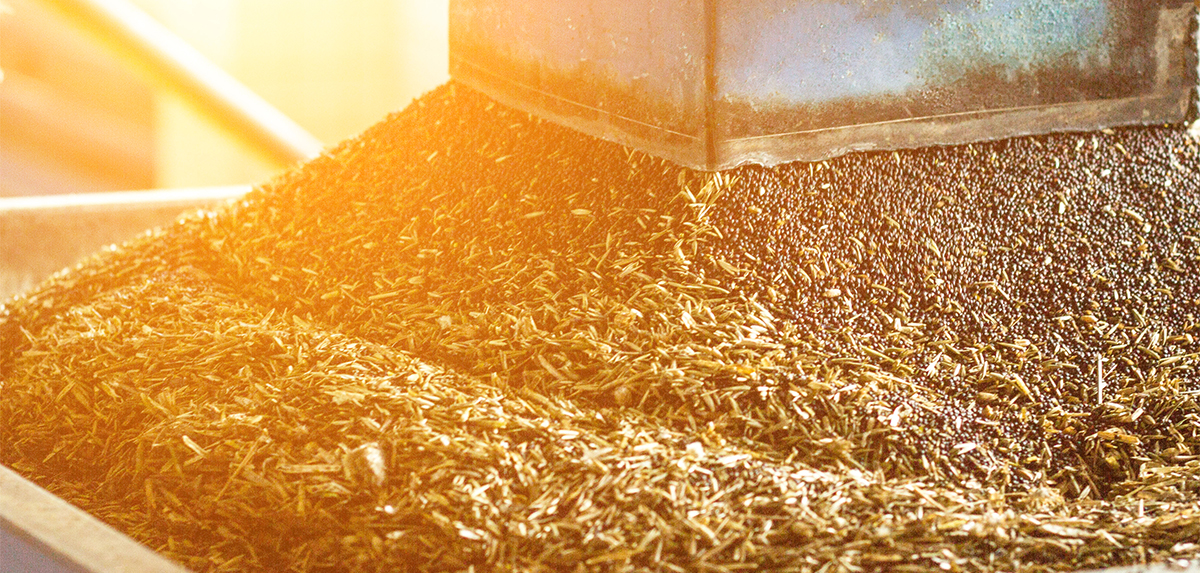
No matter how similar two oilseed processing facilities are, even when processing the same material on the same type of machine, the final product will inevitably be different. Certainly, there is a science to the oil milling process, and a majority of the processors we work with document settings for each seed type and strategically alter parameters to change the outcome. But there is an art to it, too. The best operators develop a feel for the process and have an eye for when a press is functioning ideally to produce the best quality products.
One area operators can watch for variation in the process is monitoring the amount of fines, or foots, extruding from an Expeller barrel. A certain amount of footing, around 10% to 15% by weight, is standard. Excessive footing or a complete lack of fines are signs of an issue that can reduce quality and productivity and increase costs for the processing facility.
An experienced processor will recognize signs of irregular footing, identify the root cause, and make all necessary adjustments. But the cause of irregular fine generation is not always easily identifiable. There are many reasons your machine may not be expelling solids at an ideal rate with your oil.
Let’s take a look at five factors affecting fine generation in your screw press.
1. Seed quality
Seeds are organic raw material and are naturally highly variable depending on seed type, where they were harvested, and that particular season’s weather fluctuations. The variable nature of the seed poses challenges during processing. Additionally, seed handling and storage prior to oil extraction can alter the final product. One common issue is when seed is exposed to excessive heat during storage, it degrades the seed’s protein and alters it from its natural state. The degraded material will turn into powder when pressure is applied during processing, resulting in a significant increase in the oil’s fines.
2. Seed preparation
Likewise, heat damage during seed preparation will also result in excessive fines. For an oilseed press to run efficiently and yield a high-quality product, the incoming seed must be cleaned, dehulled, crushed, and conditioned. This preparation, done with a machine like the Dox Extruder, ruptures the oil-containing bodies within a seed and generates frictional heat that deactivates harmful enzymes, reduces moisture content, and cooks the proteins. This cooking gives the seed more structure, allowing it to withstand higher forces in the press without falling apart. Too much heat, however, will damage the protein structure, and the press will turn it into powder that will extrude with the oil.
3. Pressure
Continuous pressure is one of the most basic principles of oil extraction. The amount of product in the press and the choke setting impact the amount of pressure placed on the material as it moves through the press. Too much pressure in the machine will result in excessive fines extruding from the barrel. On the other hand, not enough pressure yields very few fines and leaves too much oil in the Expeller cake, significantly reducing productivity. The press must be operated at a designated rate according to specifications to ensure oil is extracted efficiently without causing an excessive amount of footing.
Need assistance with your oilseed equipment now?
Do not hesitate to call us at 1(800) 336-4730 or use our contact form.
4. Barrel spacing
The barrel is where a processor can visually inspect for fine generation in the press. It is also another area where, if not properly set up, it can cause too little or too much fine generation. There is not a single set of rules for setting the gaps in a drainage barrel. The variable nature of the seeds and upstream preparation will impact how the liquid separates from the solid. A barrel’s spacing must be adjusted based on a machine’s response to a material. Solids extruding from a barrel indicate that spacers need to be tightened up. Conversely, if the oil is not draining quickly enough, it suggests a need to open up the spacing.
5. Worn out parts
Even with high-quality material, proper pre-treatment, and a barrel that is expertly spaced, there still may be excessive fine generation in a press. A final consideration should be to inspect machine parts for excessive wear. A common location for wear is in the drainage barrel. The continuous squeezing of material between the bars eventually wears the steel and can create openings larger than the spacing. Ultimately, this will result in too many fines extruding out of the bars with the oil.
Process knowledge can optimize your plant
A strong processor should have an eye for noticing an inappropriate amount of fines generation in the press. Without this process knowledge, a plant will operate sub-optimally, with decreased efficiency affecting its profitability. That’s where Anderson’s experience and process knowledge add value to oilseed customers. Our team at Anderson has set up processing lines for every seed type and end product. Our experts can show you how to identify problems, optimize your plant, and increase the quality and yield of your end-products.
For more information on how Anderson can help with process knowledge and increase your plant’s profitability, contact us today.